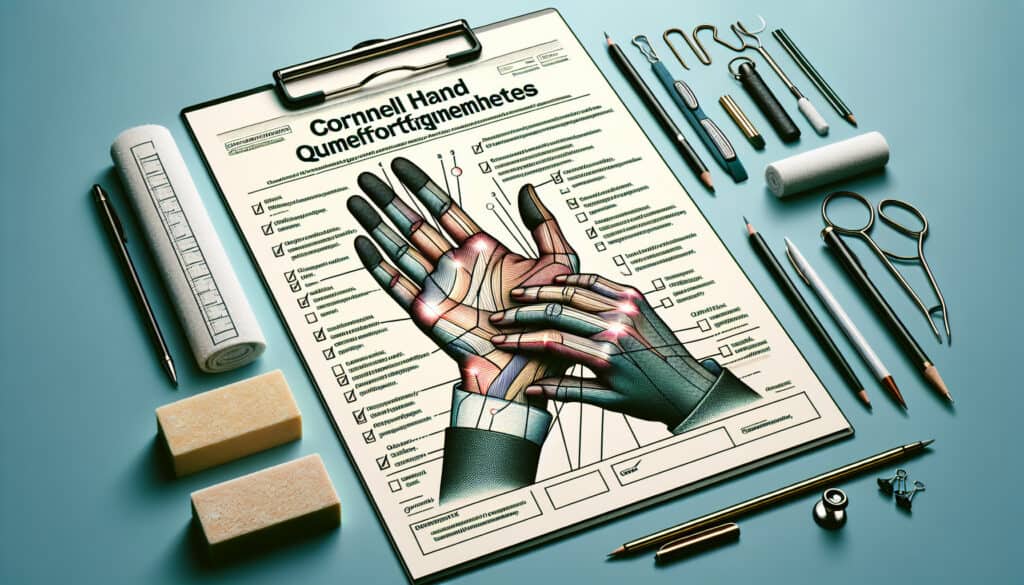A set of questionnaires used to assess the severity, frequency, and location of musculoskeletal discomfort in the hands, wrists, and forearms.
- Methodologies: Customers & Marketing, Economics
Cornell Hand Discomfort Questionnaires

Cornell Hand Discomfort Questionnaires
- Ergonomics, Health Sciences, Human Factors, Human Factors Engineering (HFE), Process Improvement, Quality Control, Quality Management, Risk Management, Safety
Objective:
How it’s used:
- These are self-administered surveys where individuals rate their level of discomfort in different body parts on a diagram. They are used in ergonomic surveillance to identify individuals or tasks that may pose a risk for injury.
Pros
- Simple and quick for users to complete, provides a standardized way to collect subjective discomfort data, and helps in the early identification of potential musculoskeletal issues.
Cons
- Data is subjective and relies on self-reporting, may not directly identify the cause of the discomfort, and should be used as part of a broader ergonomic assessment, not in isolation.
Categories:
- Ergonomics, Human Resources, Risk Management
Best for:
- Screening for and tracking the prevalence of upper limb discomfort in a workforce to prioritize ergonomic interventions.
The Cornell Hand Discomfort Questionnaire (CHDQ) is a valuable tool for assessing discomfort in the upper limbs, particularly in environments where repetitive motions or awkward postures are prevalent, such as manufacturing, assembly lines, and office settings. This survey can be particularly useful during the evaluation phase of workplace design or when implementing new ergonomic strategies, allowing designers and engineers to amend processes or workstations based on quantified feedback from employees. Key participants in this assessment include ergonomists, occupational health specialists, safety managers, and employees themselves, ensuring a comprehensive perspective on discomfort levels. The CHDQ not only serves as a screening tool but also aids in longitudinal studies to track changes in discomfort over time, facilitating proactive adjustments to workplace ergonomics and supporting injury prevention strategies. Typical applications also include integration into health and safety programs within various industries, such as healthcare and warehousing, where it becomes part of regular health assessments. The simplicity and speed of the questionnaire attract more individuals to participate, ensuring that data collected is reflective of the actual conditions experienced by workers. With regular data collection and review, organizations can prioritize which interventions would yield the greatest impact on worker wellbeing and productivity, ultimately leading to a reduction in work-related musculoskeletal disorders and associated absenteeism.
Key steps of this methodology
- Select the body parts to be assessed on the provided diagram.
- Rate the level of discomfort for each selected body part using the defined scale.
- Note any specific tasks associated with reported discomfort.
- Document the frequency and duration of discomfort episodes.
- Identify any potential risk factors or ergonomic issues related to tasks performed.
Pro Tips
- Incorporate a psychometric assessment to validate the questionnaire’s effectiveness in measuring discomfort, ensuring that responses accurately reflect the workers' experiences.
- Utilize longitudinal data collection to track discomfort trends over time, correlating findings with specific interventions to assess their impact on reducing musculoskeletal issues.
- Complement the questionnaire with qualitative interviews or focus groups for deeper context around reported discomfort, allowing for more targeted ergonomic solutions.
To read and compare several methodologies, we recommend the
> Extensive Methodologies Repository <
together with the 400+ other methodologies.
Your comments on this methodology or additional info are welcome on the comment section below ↓ , so as any engineering-related ideas or links.
Historical Context
1986
(if date is unknown or not relevant, e.g. "fluid mechanics", a rounded estimation of its notable emergence is provided)

Related Posts
Master Production Schedule (MPS)
Mass Customization
Marketing Funnel
Marketing Audit
MAPO Index (Movement and Assistance of Hospital Patients)
Manufacturing Resource Planning (MRP II)